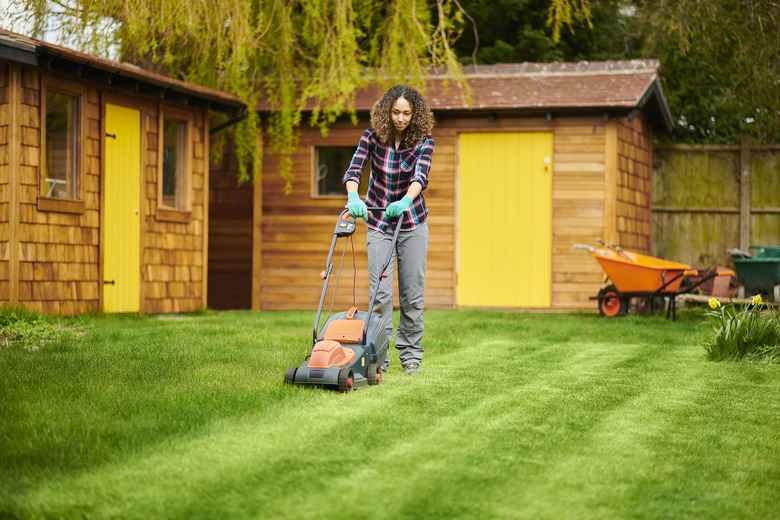When Can You Mow The Lawn After Fertilizing?
We may receive a commission on purchases made from links.
Properly mowing your lawn is essential to its good health and growth. Fertilizing gives the turfgrass the nutrients it needs for strong roots and lush growth, resulting in a carpet of green. After fertilizing, it's important to mow at the correct time to give the nutrients time to seep into the soil and start their job of feeding your turfgrass. By mowing too soon, you run the risk of moving granular fertilizers from their desired spot and having spotty coverage areas.
Tip
When you mow after fertilizing depends on the product used. If you use a liquid fertilizer, you can mow after the product has completely dried on the grass. If using a granular blend, wait at least 24 to 48 hours before mowing.
Mowing After Using Starter Fertilizers
Mowing After Using Starter Fertilizers
Starter fertilizers are used to get a new lawn or repaired areas off to the best start possible. Soil tests are usually advised to know exactly what nutrients your soil lacks before you install seeds, plugs, or larger pieces of sod. The soil test also lets you know what blend of starter fertilizer is best for your particular soil conditions. Giving your seeds, plugs, or sod the added nutrients a starter fertilizer contains promotes healthy grass through stronger root growth, quicker growth, and a lush green appearance. Healthy turfgrass means fewer problems with pests or diseases.
Before you start mowing your new turfgrass, it's important to give it enough time to take root and grow. The last thing you want to do is injure your newly developing grass by mowing too soon after planting. Depending on whether you used seeds, plugs, or sod, you may have to wait anywhere from several weeks to up to six before you mow. Wait until the new turf is one-third taller than the particular grass's desired mowing height. For example, if your particular grass has a 3-inch desired height, mow when the new grass reaches 4 inches tall.
Mowing After Seasonal Fertilizer Applications
Mowing After Seasonal Fertilizer Applications
Fertilizing your grass periodically throughout the growing season promotes healthy growth. This assures your turf continues to get the nutrients it requires for problem-free growth. Keeping the turf healthy through regular feedings also cuts down sparse growth, which promotes weed growth as well as problems with pests and diseases. So that the fertilizer reaches the soil without interference, it's ideal to mow your lawn and do any raking before you apply fertilizer. Grass that's been allowed to grow long can interfere with the fertilizer making good contact with the soil. Always water granular fertilizers into the area after applying to prevent burning.
Lawn fertilizers come in either liquid blends or granular types, and when you can mow after applying depends on what type you used. If you applied a liquid fertilizer, you can mow as soon as the product dries on the turfgrass. However, if you fertilize using a granular type, you should wait at least 24 to 48 hours before you pull out the mower and start cutting.
Mowing Considerations for Turfgrass Health
Mowing Considerations for Turfgrass Health
Cutting your turfgrass regularly through the growing season promotes the best growth, resulting in a thicker lawn. If you've stored your mower throughout winter, it's best to get it checked to make sure everything is in working order before you have to start using it to tackle the growth. Make sure you're cutting with sharp blades that cut the grass instead of ripping it. You also want to cut dry grass instead of wet grass because you can leave ruts in the yard, and the cut grass isn't cut as finely and has a tendency to clump. Mowers can also bog down in wet conditions, making it harder to mow.
Each type of turfgrass has its own desired mowing height but sticking to the one-third rule where you never remove more than one-third of the new growth keeps the grass healthy. You don't want to mow so low that you scalp the grass because this opens it up to weed growth and pest and disease problems. Don't forget to remove any debris from the mowing area before you start and wear safety gear, like closed-toe shoes and safety eyewear. Keep children and pets away from the area while you work.
References
- University of Florida IFAS Extension: Planting Your Florida Lawn
- North Dakota State University: How to Mow Your Lawn
- Garden Tool Expert: Mowing After Fertilizing – This Is the Best Way To Do It
- Scotts: The Questions People Ask Most About Lawn Fertilizing
- University of Rochester Medical Center: Safety Tips: Things to Know Before You Mow
